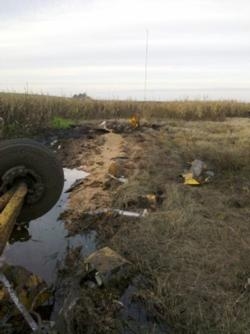Fri, May 24, 2013
Move The Result Of Three Accidents Involving Airplanes Colliding With Meteorological Evaluation Towers
The NTSB has issued six broad-reaching safety recommendations after three accidents in which airplanes collided with Meteorological Evaluation Towers (METs). In each of the accidents, which occurred between 2005 and 2011, the MET was unmarked and unlighted. All resulted in fatal injuries. In the 2011 case, the permit for the MET had expired more than a year before the accident occurred, but it had not been removed as stipulated by its permit. The Board says that METs are often temporary structures, and at under 200 feet tall, are not required to be marked and lighted by the FAA.

The Board recommends that the FAA amend 14 Code of Federal Regulations Part 77 to require that all meteorological evaluation towers be registered, marked, and—where feasible—lighted, and that the agency create and maintain a publicly accessible national database for the required registration of all meteorological evaluation towers.
They further recommend that the American Wind Energy Association revise the Wind Energy Siting Handbook to clearly indicate the hazards that meteorological evaluation towers (MET) pose to low-altitude aviation operations and encourage voluntarily marking them to increase their visibility by reference to Advisory Circular70/7460-1, “Obstruction Marking and Lighting.” The association should also inform members about the circumstances of the airplane accidents that have occurred in connection with the presence of meteorological evaluation towers (MET) and emphasize the importance of understanding the aviation safety hazards associated with METs when erecting them.
The Board says that in the review and approval of applications processes for the construction of METs conducted by the United States Department of the Interior, the United States Department of Defense, and the United States Department of Agriculture, applicants should be provided a copy of, or directed to Advisory Circular 70/7460-1, “Obstruction Marking and Lighting.”
Finally, the board urged 46 States, the District of Columbia, the commonwealths of Puerto Rico and the Northern Mariana Islands, and the territories of America Samoa and the U.S. Virgin Islands to pass legislation requiring that meteorological evaluation towers be marked and registered in a directory.
(NTSB image of accident site with MET visible in the background)
More News
He Attempted To Restart The Engine Three Times. On The Third Restart Attempt, He Noticed That Flames Were Coming Out From The Right Wing Near The Fuel Cap Analysis: The pilot repor>[...]
Make Sure You NEVER Miss A New Story From Aero-News Network Do you ever feel like you never see posts from a certain person or page on Facebook or Instagram? Here’s how you c>[...]
From 2009 (YouTube Edition): Leading Air Show Performers Give Their Best Advice for Newcomers On December 6th through December 9th, the Paris Las Vegas Hotel hosted over 1,500 air >[...]
Aero Linx: NASA ASRS ASRS captures confidential reports, analyzes the resulting aviation safety data, and disseminates vital information to the aviation community. The ASRS is an i>[...]
“For our inaugural Pylon Racing Seminar in Roswell, we were thrilled to certify 60 pilots across our six closed-course pylon race classes. Not only did this year’s PRS >[...]
 NTSB Final Report: Rutan Long-EZ
NTSB Final Report: Rutan Long-EZ ANN FAQ: Turn On Post Notifications
ANN FAQ: Turn On Post Notifications Classic Aero-TV: ICAS Perspectives - Advice for New Air Show Performers
Classic Aero-TV: ICAS Perspectives - Advice for New Air Show Performers ANN's Daily Aero-Linx (06.28.25)
ANN's Daily Aero-Linx (06.28.25) Aero-News: Quote of the Day (06.28.25)
Aero-News: Quote of the Day (06.28.25)



